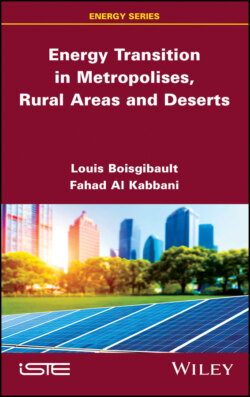Energy Transition in Metropolises, Rural Areas, and Deserts

Реклама. ООО «ЛитРес», ИНН: 7719571260.
Оглавление
Louis Boisgibault. Energy Transition in Metropolises, Rural Areas, and Deserts
Table of Contents
List of Tables
List of Illustrations
Guide
Pages
Energy Transition in Metropolises, Rural Areas and Deserts
Foreword
Preface
Acknowledgments
List of Acronyms
1. Three Types of Space for Analyzing Energy Transition. 1.1. From energy-to-energy transition
1.2. Presentation of the six research areas. Box 1.1.Characteristics of the six research areas
1.3. The importance of climates in the energy transition
1.4. Energy sectors analyzed by field
Box 1.2.Energy sectors studied by field
2. Energy Transition in Metropolises. 2.1. Energy characteristics in metropolises
2.2. The example of Riyadh in Saudi Arabia. 2.2.1. Presentation of Riyadh. Box 2.1.Riyadh identity card
2.2.2. Development, construction and housing of Riyadh. 2.2.2.1. Major developments in Riyadh
From 1967 to 1975
From 1975 to 2000
From 2000 to today
2.2.2.2. Buildings and housing in Riyadh
2.2.3. Transport from Riyadh
2.2.4. Riyadh’s challenges for energy transition
2.3. The example of the European Metropolis of Lille in France. 2.3.1. Presentation of the European Metropolis of Lille. Box 2.2.Characteristics of the European Metropolis of Lille
Box 2.3.Competences of the European Metropolis of Lille
2.3.2. Development, construction and housing of the European Metropolis of Lille. 2.3.2.1. Major developments in the European Metropolis of Lille
2.3.2.2. Construction and housing in the European Metropolis of Lille
2.3.3. Transport of the European Metropolis of Lille
Box 2.4.Transport networks of the European Metropolis of Lille
2.3.4. Challenges of the European Metropolis of Lille for the energy transition
2.4. Lessons learned from the energy transition in metropolises
2.4.1. Priority to controlling energy consumption in metropolises
2.4.2. Microproduction of energy in metropolises
2.4.3. Peripheral power generation units and networks
3. The Energy Transition in Rural Areas. 3.1. The characteristics of energy in rural areas
3.2. The example of Pays de Fayence in France. 3.2.1. Presentation of Pays de Fayence. Box 3.1.Characteristics of the Pays de Fayence
3.2.2. Development of the Pays de Fayence. 3.2.2.1. A territorial coherence scheme currently being adopted
Box 3.2.Competences of the community of communes of the Pays de Fayence
3.2.2.2. Major developments in the Pays de Fayence. Roman aqueduct
Two hydroelectric power plants on the Siagne
Malpasset Dam
Saint-Cassien Dam and the development of its banks
Pays de Fayence High School Project
Callian Photovoltaic Park
Box 3.3.Characteristics of the preliminary design of the photovoltaic power plant
Box 3.4.Characteristics of the solar power plant after 1 year of operation
3.2.3. Transport in the Pays de Fayence
3.2.4. Challenges of the Pays de Fayence for the energy transition
3.2.4.1. Energy consumption
3.2.4.2. Energy production
3.2.4.3. Supply–demand balance
3.2.4.4. Electricity transmission
3.2.4.5. Electricity distribution
3.3. The example of Bokhol in Senegal. 3.3.1. Presentation of Bokhol. Box 3.5.Features of Bokhol
3.3.1.1. The need for a vision
3.3.1.2. Energy choices to ensure security of supply
3.3.1.3. Production capacities and regional integration
3.3.1.4. Social development and pricing
3.3.1.5. The regulatory framework
3.3.1.6. Energy efficiency
3.3.1.7. African intelligent cities
3.3.2. Development of the Bokhol site
3.3.3. Bokhol’s challenges for the energy transition
3.4. Lessons learned from the energy transition in rural areas
3.4.1. Dynamics of positive energy territories
3.4.2. Complex regulations and rurality
3.4.3. Landscapes and rurality
4. The Energy Transition in the Desert. 4.1. The characteristics of energy in the desert
4.2. The example of Ouarzazate in Morocco. 4.2.1. Presentation of Ouarzazate. Box 4.1.Characteristics of Ouarzazate
4.2.2. Spatial planning in Ouarzazate
4.2.3. Ouarzazate’s challenges for the energy transition
4.3. The example of Neom in Saudi Arabia. 4.3.1. Neom’s presentation. Box 4.2.Features of Neom
4.3.2. Development of the Neom project. Box 4.3.Characteristics of Neom’s energy projects
4.3.3. Neom’s challenges for the energy transition
4.4. Lessons learned from the energy transition in the desert
Conclusion: Widespread Digitalization of Society: A (in)Complete Process? C.1. Solutions for metropolises
C.2. Solutions for rurality
C.3. Solutions for the desert
References
Index. B
C
D, E
F, G
H, I
K, L
M, N, O
P, R
S, T
U, V, W
WILEY END USER LICENSE AGREEMENT
Отрывок из книги
Series Editor
.....
Solar energy can take many forms. The French physicist Edmond Becquerel discovered the photovoltaic effect in 1839. This is one of the effects that is implemented in photovoltaic cells from solar radiation. It is used to produce electricity. Solar thermal energy makes it possible to produce heat and hot water from solar collectors. Concentrated thermodynamic solar energy converts solar energy into heat at high temperature and then converts it into electricity. The sun’s rays are concentrated on a heat transfer fluid in several possible configurations and heated to very high temperatures to produce heat. The four technological fields are cylindro-parabolic mirrors, Fresnel mirrors, the solar tower and the parabola stirling. Building integrated solar photovoltaics and solar thermal can enable urban and rural buildings to produce electricity and heat. Solar streetlamps can help with street lighting. Ground-based photovoltaic farms can only be designed in large rural and desert areas. Concentrated thermodynamic solar energy is intended for the desert.
The methods of evaluating energy systems and their importance are beginning to be fully recognized (Lachal 2018). The concepts of energy and technological systems, innovation, learning through use and feedback must be analyzed from the perspective of the host territories.
.....